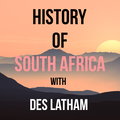
Episode 169 - The Kat River Settlement seethes and the inglorious treachery of Sandile’s arrest
Loading player...
First off, a big thank you to those listeners who’ve been sending me emails, a great deal of useful information emerges from our discussions which always improves the quality of this podcast, specifically thanks to John for sending me your book and to Doctor Nkosi for the contact in eSwatini.
When we left off in episode 168, pressure was being exerted on the Kat River Settlement by the new Governor, Sir Henry Pottinger.
A quick revisit. The Kat River Settlement came into being in I829 after a clash on the eastern border when the authorities of the Cape Colony expelled amaXhosa from land around the source of the Kat River.
To prevent them from re-occupying the area when the soldiers withdrew, the colonial government decided to settle it with English settlers and Khoekhoe and bastaards. Andries Stockenstrom who was then the Commissioner General of the eastern districts, wanted to intersperse the two races and give them equal quantities of land. But his superiors insisted on placing the khoe in the most exposed military positions, then gave the Khoe smaller land-grants than the English settlers received.
What is really fascinating is how many types of people lived in this small area — people who differentiated themselves based on their ancestry. The party at the confluence of the Kat and Mankanzana Rivers for example belonged to that class of mixed race South Africans known to the colonists as 'Bastaards', who had adopted Dutch clothing, religion, technology and language, and did not associate themselves with their Khoi heritage.
In May 1847 Governor Sir Henry Pottinger appoint a bankrupt farmer and a man who was known as a great hater of the Khoekhoe to oversee the Kat River Settlement. Thomas Jarvis Biddulph was appointed magistrate and immediately there were issues. Andries Stockenstrom said Biddulph’s moral character “could not bear scrutiny” and the new magistrate launched into a series of verbal and physical attacks on the Khoekhoe living along the Kat River and Blinkwater.
He called them “a lazy set of paupers” and said that they would be better served working as labourers for the English settlers and the Boers. Just to reinforce his view, Biddulph pulled a tax stunt — increasing their tax from eighteen pence to six shillings. From eighteen cents to sixty cents. How about that for a tax hike, that’s 43 percent. If you tried that these days, the scratching sound of matches would be heard across the land.
This historic site didn’t have long to go before it would be eviscerated by colonial jealousy. Even the former supporters, the missionaries, appeared to lose faith. One of the most ardent was Henry Calderwood. His idealism had evaporated — living on the frontier had shattered his liberal attitudes, and now he seemed to swap one obsession for another.
One of the things that had driven Pottinger up the wall was the fact that the amaNgqika had continued to insist that they were at peace without admitting that they had been defeated, and by Sandile’s refusal to resume negotiations. On the 7th August 1847 Sandile’ had been formally declared a rebel.
Then the whole situation worsened, and fast. Pottinger resorted to proclaiming that the amaMfengu, the Boers and the Khoekhoe who fought with his regular soldiers could seize whatever they liked from the amaXhosa. The full-scale invasion of the Amathola’s began again on the 29th September 1847, and every grain pit was emptied, every single animal seized.
When we left off in episode 168, pressure was being exerted on the Kat River Settlement by the new Governor, Sir Henry Pottinger.
A quick revisit. The Kat River Settlement came into being in I829 after a clash on the eastern border when the authorities of the Cape Colony expelled amaXhosa from land around the source of the Kat River.
To prevent them from re-occupying the area when the soldiers withdrew, the colonial government decided to settle it with English settlers and Khoekhoe and bastaards. Andries Stockenstrom who was then the Commissioner General of the eastern districts, wanted to intersperse the two races and give them equal quantities of land. But his superiors insisted on placing the khoe in the most exposed military positions, then gave the Khoe smaller land-grants than the English settlers received.
What is really fascinating is how many types of people lived in this small area — people who differentiated themselves based on their ancestry. The party at the confluence of the Kat and Mankanzana Rivers for example belonged to that class of mixed race South Africans known to the colonists as 'Bastaards', who had adopted Dutch clothing, religion, technology and language, and did not associate themselves with their Khoi heritage.
In May 1847 Governor Sir Henry Pottinger appoint a bankrupt farmer and a man who was known as a great hater of the Khoekhoe to oversee the Kat River Settlement. Thomas Jarvis Biddulph was appointed magistrate and immediately there were issues. Andries Stockenstrom said Biddulph’s moral character “could not bear scrutiny” and the new magistrate launched into a series of verbal and physical attacks on the Khoekhoe living along the Kat River and Blinkwater.
He called them “a lazy set of paupers” and said that they would be better served working as labourers for the English settlers and the Boers. Just to reinforce his view, Biddulph pulled a tax stunt — increasing their tax from eighteen pence to six shillings. From eighteen cents to sixty cents. How about that for a tax hike, that’s 43 percent. If you tried that these days, the scratching sound of matches would be heard across the land.
This historic site didn’t have long to go before it would be eviscerated by colonial jealousy. Even the former supporters, the missionaries, appeared to lose faith. One of the most ardent was Henry Calderwood. His idealism had evaporated — living on the frontier had shattered his liberal attitudes, and now he seemed to swap one obsession for another.
One of the things that had driven Pottinger up the wall was the fact that the amaNgqika had continued to insist that they were at peace without admitting that they had been defeated, and by Sandile’s refusal to resume negotiations. On the 7th August 1847 Sandile’ had been formally declared a rebel.
Then the whole situation worsened, and fast. Pottinger resorted to proclaiming that the amaMfengu, the Boers and the Khoekhoe who fought with his regular soldiers could seize whatever they liked from the amaXhosa. The full-scale invasion of the Amathola’s began again on the 29th September 1847, and every grain pit was emptied, every single animal seized.

